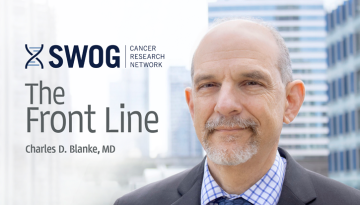Patient-Reported Outcomes on the Rise in SWOG
This week, we feature guest bloggers Dr. Lynn Henry and Dr. Michael Fisch, co-chairs of the symptom control and quality of life committee.
During our SWOG meeting in Chicago last month, the symptom control and quality of life committee and the patient advocate committee co-sponsored a special symposium entitled “Patient-Reported Outcomes Symposium: Approaches, Tools, Electronic Data Capture.” We organized the event for a few reasons. The central one: these health-related outcomes are valuable tools that can improve our trials – and make our work truly patient focused.
Patient-reported outcomes, or PROs, are any trial outcomes reported by participants. A subset of PROs are Health-Related Quality of Life (HRQOL) measures, which help investigators evaluate the impact of illness or treatment on the physical, emotional, and social aspects of quality of life (QoL). PROs are broadly applicable across SWOG, both to disease and cancer control committees. In the disease committees, PROs are used to understand key domains of patient experience and QoL as a secondary endpoint, and also enhance understanding of some dimensions of drug toxicity when comparing different anti-cancer therapeutics. In symptom research, PROs are often appropriate primary endpoints of interventional studies taking aim at specific symptoms.
Because PROs can clarify and deepen our understanding of the impact of treatments, their use is on the rise. PROs even landed a high-profile plenary spot this month at ESMO 2016 in Copenhagen, when CheckMate researchers announced that head and neck cancer patients treated with nivolumab stayed healthier longer, and experienced less pain, fatigue, and insomnia than patients receiving standard treatment. There are also exciting developments in the field of PROs, including the rollout of a patient-reported version of the Common Terminology Criteria for Adverse Events called PRO-CTCAE. The PRO-CTCAE does not replace the CTCAE entirely, but it improves certain toxicity assessments that are best reported directly by the patient. Finally, we held the symposium to address a key issue facing all of us in SWOG – how and when to incorporate PRO assessments into our therapeutic trials. This is an especially important topic in an atmosphere of limited resources and increasing trial complexity.
So we had a lot to talk about in Chicago. And the symposium featured a number of excellent presentations. You can view the audio and slides on the web.
(Thanks to The Hope Foundation and the presenters for their support and generosity).
Some key messages from the session:
We can be contacted at lynn.henry@hci.utah.edu or fischm@aimspecialtyhealth.com.
Other Recent Stories



